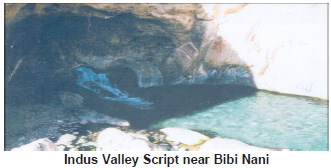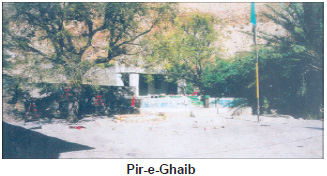Bibi Nani of
Baluchistan
By Sanjay
Godbole
There is a
small village
called Kolpur at a
distance of 25
Kilometers towards South from
Quetta the capital of
Baluchistan. It is situated just
near the entrance of the ‘Bolan’
pass. The river ‘Bolan’ stems
from here only. Evidences of
many ancient human settlements
have come to light from
the surroundings of this river.

‘Kolpur’ Chiefly abounds in
fruit laden gardens and Date
trees. But, a village named
‘Much’ near the
railway lines
is a dry, and barren place, and
has huts constructed in mud.
As one proceeds, from ‘Much’
one comes across coal mines at
a distance of 24 Kilometers and
then to wards right, an uneven
and wide path takes you to a
place called
‘Pir-e-Ghaib’.
Here there is a Kund (Water
tank) made in stone and gets
its supply of water from a
waterfall. So also, this place
has
many Crags of mountains and
innumerable trees in its
proximity. There is a similar
Kunda a Little downstream
and is perenially brimful with
clear and pure water. There is
a sacred spot near this Kund.
From ‘ Pir- e- Ghaib’just at a
distance of five kilometers is
situated a place called Bibi
Nani. Due to the heavy down
pour in Baluchistan in the year
1986. the historically
important bridge was
completely washed away. If one
proceeds from over here, to
Sirajabad he comes across
several water Kundas (tanks).
These contain accumulated
reserves
of hot and cold water.
This place is considered as one
of the delightfully charming
spots in Baluchistan on
account of the thickly wooded
Landscapes and scenic beauty
of the Kundas of water.
Tourists of Foreign origin,
however, are not permitted to
tour this area, unless specially
permitted to do so by the
authorities of the Government
of Pakistan.
At the far end of the ‘Bolan’
Pass and near the base of the
mountain, there is a simple
and ordinary mausoleum. A
thick green cloth is always
rolled up.
On the rocky crags, nearby,
some ageold figures seem to
have been depicted. It is said
that these figures are
associated with the revered
Bibi Nani. A local tale makes
rounds in this area as to when
the Zarathrustian religion was
dominant all over Baluchistan,
Bibi Nani and her brother
arrived here with expansionist
propagation of Islam. Then the
brother of Bibi Nani entered the
wall in the mountain. Therefore
he was popularly called as ‘Pir
- e - Ghaib’ [The invisible
Saint]. Mr. Salman Rashid- the
famous author from Pakistan
has the following version of the
said story. As per his version,
the Cracked fissure in the wall
in the rock is on account of the
continuous flow of hot water
with traces of sulphur, through
it and has formed layers of the
Greenish, blue and Brown
tinges. At present the Baluchi
Muslims call this place as Pire-
Ghaib and Hindus here rever
this spot as the place of
worship for Lord Mahadev
(Shiva). Many of those, who are
fortunate enough, to have their
vows fulfilled tie many things
to a nearby tree. As compared
to ‘Pir- e- Ghaib’ the mausoleum
of Bibi Nani (venerated
lady) has been simple and is
also not associated with fables
and stories full of bizarre
accounts. At both the above
mentioned places no stone
inscriptions
are found. But the
sacred spot of Bibi Nani is
situated
at an important place,
namely an ancient East-West
highway. From this place, the
Indian Sub continent was
directly linked to
Mesopotamia. From here only
roads take off for Mohan- jodado;
Mehergarh and other important
centres of Sindhu
(Indus valley) culture. So also
important roads leading to
trade centres on coastal areas
were in existence from the 9th
century B.C..
In the opinion of many
erudite and archaeologists,
there is no secrecy or mistcity
in the history of Bibi Nani. But
the roots of her legendary
history lie in the sect of
Goddess Nana or Nania. This
Goddess Nana or nania was
being worshiped in Iran and
Mesopotamia in ancient times.

King Kudur Nankhundi of
Elam of Southwest Iran invaded
the empire of’Ur in
Mesopotamia in the year 2280
B.C. and looted the city or
‘Erech’. The idol of Goddess
Nana was one of those precious
effects which found its their
way to Susa in Iran. It was
installed in one of the temples
of Susa and was worshipped,
After hundreds a years, when
the empire of Elamite was
weakened and infriled, the king
of Mesopotamia Assurbanipal,
invaded Susa, the capital of
Iran and looted 14 cities near
by and took back the icon of
Goddess Nania and reinstalled
the same in a temple of Erech.
The sect worshipping
Goddess Nania or Nana Devi
Happens to be one of the most
ancient sects, having a rich
tradition of about 4300 years.
The group of traders effecting
trade for centuries between
Indus culture and Mesopotamia
have introduced this
Goddess to the outside world.
The name Nana or Nania
continued to prevail over here
and even as on today, this name
continues albeit with few
changes, in Baluchistan.
Mr. Salman Rashid,
through an article in the Daily
Times of Pakistan poses a
question for the Western
erudites as to why they tried to
solve many such and similar
other puzzles within the frame
work of Cuneiform Tablets : and
as to why they have conveniently
forgotten to take
cognizance of the fact that this
ambiguity could also have a
reference to the civilization in
Indus valley. Mr. Mark Kenoyer
is a famous archaeologist and
has done a lot of research on
Indus civilization. He is of the
opinion that the Indus
civilization
has a close and intimate
relationship with
Mesopotamia Viz- a - viz trade,
arts and culture point of view.
The art practiced and the
civilization prevailing there,
was of a very high standard.
Mr. Kenoyer further states that
the doubtful possibility as to
whether or not prior to the king
of Iran taking the idol of
Goddess
Nania to Iran, chances are
the traders and artists in the
Indus civilization could
possibly have taken the sect of
Goddess Nania to the west in
Mesopotamia. Mr. Kenoyer
further reaffirms that he very
faithfully believes that Goddess
Nana or Nania must have been
worshipped in her original form
in cities existing in Indus
civilization and that the said
Bibi Nani is nothing but the
changed version [For the people
of Pakistan] of the Goddess
worshipped in the Indus
Civilization for thousands of
years and the Goddess Nana or
Nania for the ancient
Mesopotamia. The second best
sacred spot in Baluchistan
could possibility be declared as
a place of worship for the
Goddess under the disguise of
guarding and protecting the
vast expanse of fresh water
reserve. Some eight thousand
years back, the Caravans of
traders and others proceeding,
resting here near the water
reserves,
worshipping the
Goddess and proceeding further
en- route and this spot was
later on addressed as ‘ Pir- e-
Ghaib’.
In the writings of Akkadian
tablets there are stray
references to some Elamite
deities right from Asia Minor
to Susa in Iran during the
Persian era, the popular Nania
sect shows some striking
similarities with ‘Anahita’
mentioned in Avesta. Anahita
is a water Goddess and is
associated with fertility and
functional genetics. The
Goddess ‘Ninni’ has been
depicted with the king’
Anubanimi’ of lulubi in carving
on the Mountain near the
entrance
gate of the village
‘Saripul’ on the ancient
highway connecting Baghdad
with Tehran. A Picture of deity
‘ Kiririsha’ - a Goddess of
fertility from Susa is shown on
a plate used while celebrating
the fulfillment of a vow.
According to some scholars, all
the qualitative virtues of the
Goddess ‘Anahita’ haye since
been adopted from the Goddess
‘Annat’ of Syria.
The Goddesses ‘Inana’ and
‘Ishtar’ and the Goddesses’
Kiririsha’ and ‘Nania’ belong to
the same sect and traditions,
the trio of Goddesses
Ahurmazda, Anahita and
Mither, when seen in
Akhmenian writing of
Cuneiform, shows Anahita
with Mither. A temple of
Goddess Anahita’ still does
exist since the Sassani era at
Istakhar in Iran. So also her
holy temples do exist at other
locations in Iran. At Susa she
was worshipped as Goddess’
Nania’. In olden times, there
were sects which did esteem
and revere the Goddess Nania
in Countries outside Iran such
as Lydia, Armenia and
Cappadosia. In Iran, in the
Sculpture showing Naqsh - e -
Rustum, the King of Iran is
shown as receiving the enblem
of honour at the hands of
Goddess Anahita. In the
famous sculpture of Tak- e-
Bustan, Khusru the Second is
shown as receiving the Royal
enblem at the hands of Anahita
and Ahurmazda. Kanishka
was the most eminent and
superior
king from the Kushan
dynasty. His empire had its
tentacles spread, besides India,
upto the present Afghanistan
and some parts of Asia minor.
His era starts from the year 78
A.D. . There is a depiction of
deities belonging to several
religions on the coins struck by
him. The portrait of the Goddess
‘Nana’ is seen on the coins
struck by King Kanishka. Nana
has a half crown on her head
and an aura behind her face,
with the crescent a patera in
her left hand and a scepter with
horse head mouth in the right
hand. In the legend of the coin,
the Goddess is addressed as
‘Nana’ or ‘Nanashow’. Like
Kanishaka, the coins struck by
Huvishka also bear the portrait
of Goddess’Nana’.
Every civilization worshipped
Goddesses in primal
form. The sect of Goddess Nana
or Nania was powerful at that
time. Bibi Nani of Baluchistan
is one such spot establishing
connection of olden era with the
new one and has been
considered as an important
place of pilgrimage of Baluchistan as Hinglamata.
*(The author is a noted
Archeologist, based in Pune)
Source: Kashmir
Sentinel
| 